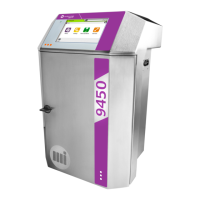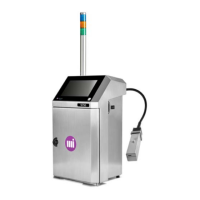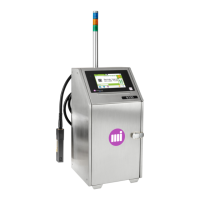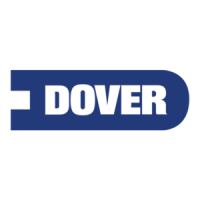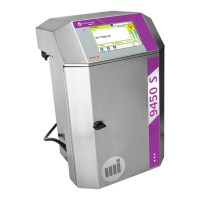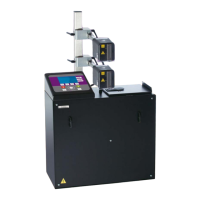Do you have a question about the Dover Markem Imaje 9040 and is the answer not in the manual?
Overview of the printer, how to use the manual, and contact information.
Details on compliance with industry standards and certifications like ISO 9001 and ISO 14001.
Essential safety instructions, security measures, health, hygiene, and fire prevention guidelines.
Guidelines for operating environment, installation, use, handling, and servicing the printer.
Information on how to recycle printer components and special methods for disposal.
Overview of the four printer models, showing heads, jets, and head types.
Identification and description of internal electronic components like PC board and power supply.
Components within the hydraulic compartment, including ink circuit and pressurization unit.
Detailed breakdown of the ink circuit components for specific printer models.
Identification of connections and components visible from the rear of the printer.
Detailed diagram and identification of individual printhead components and types.
Identifies the main areas: Operation, Screen, Navigation, and Editing.
Explains the printer power, head status, fault indicators, and fluid level indicators.
Details the screen's menu bar, printer status, menu name, editing area, and keyboard status.
Describes function keys, arrow keys, ESC, ENTER, and TAB for navigating menus and messages.
Explains the keyboard functions for message editing, including lock modes.
Comprehensive map of the printer's menu structure, covering PRODUCTION, MESSAGE EDITING, etc.
Explains the meaning and function of various icons used in the interface toolbars.
Details how to use the numeric keypad functions, including keyboard lock and specific key combinations.
Lists and explains keyboard shortcuts for navigating menus and performing actions.
Step-by-step instructions for powering up the printer and ensuring it's ready for operation.
Procedures for stopping the printer, including long and short shutdown options.
Specific procedure for stopping the printer for less than 2 hours, utilizing an "Active stand-by" mode.
How to select and assign messages to print heads from the available list.
Process for printing a message, stopping/restarting printing, and loading messages.
How to modify existing messages and user prompts within the production menu.
Step-by-step guide on how to create a new message from scratch.
How to access and view operating parameters and ink circuit parameters.
Instructions on how to open the compartment and add ink and additive.
Understanding the term "Message" and how editing area depends on printhead configuration.
Steps for saving new or modified messages and deleting messages from memory.
How to exit the message editing function, with options to save or discard changes.
How to change message parameters and the limitations for existing messages.
Adjusting scrolling action, transparency printing, inverse printing, and DIN characters.
How to select and preview fonts for characters and symbols.
Specifying time and date settings, including hour, date format, and first day of the week.
How to view and reset counter values on the printer.
Defining, inserting, and modifying user prompts for variable data entry.
Selecting barcode types and setting their parameters.
Details on Interleaved 2 of 5, Code 39, ITF 14, and ITF 6 barcode characteristics.
Configuring shift codes, including start time, interval, and type (numerical or letter).
Defining external variables to be sent via serial link, including size and symbol visualization.
Steps to compose autodating table variables using date and time elements.
How to select symbols and characters from fonts, especially for special characters or non-keyboard languages.
Procedures for saving symbols, closing fonts, and downloading fonts for use.
A practical example demonstrating how to program a message with various elements.
Procedures for printer shutdown, including for 8-15 days and over 15 days, and manual/automatic drain/flush.
Instructions for restarting the printer after it has been shut down for 8-15 days or longer.
Steps for stopping jets, positioning the head, and cleaning electrodes and cannon.
Final steps for head cleaning, including drying, opening gutter, and clearing faults.
Recommended maintenance tasks for the 3,600-hour service interval, including filter changes.
Steps for manually flushing the recovery gutter and preparing for automatic flush.
Detailed steps for connecting components and initiating the automatic drain and flush cycle.
A schematic diagram illustrating the hydraulic system of the printer.
Step-by-step guide to drain the ink tank, viscometer circuit, and main filter.
Procedure for circulating clean additive through the print head and umbilical tubing.
Steps to flush the ink circuit using cleaning solution and performing ink REFRESHMENT.
Process for refilling the ink tank, checking jets, and performing stability and refreshment routines.
Steps for shutting down the 9040 Contrast printer for 2-4 days, including jet stop and gutter cleaning.
Instructions for shutting down the 9040 Contrast printer for four or more days, emphasizing drain and flush.
Steps to restart the 9040 Contrast printer after a 2-4 day shutdown, including head cleaning.
Procedures for restarting the 9040 Contrast printer after a shutdown longer than 4 days, including filter change and viscosity check.
Steps for stopping jets, positioning the head, and cleaning electrodes and cannon.
Final steps for head cleaning, including drying, opening gutter, and clearing faults.
Maintenance tasks for the 2,000-hour service, including filter and coalescence filter changes.
Instructions for draining the additive tank and adding flushing solution.
Steps for flushing the ink circuit, cleaning the printhead, and fitting drain plugs.
How to start jets, indicators, and select automatic or manual start modes.
Steps for shutting down individual jets or all jets, and indicator lights.
Troubleshooting steps for jets that do not start correctly, including nozzle unblocking.
Function to start jets and override faults to enable adjustments.
Procedure for aligning jets by identifying the slowest and setting delay times.
Tools and initial steps for adjusting jets, including positioning and checking vacuum.
Removing protective covers, loosening screws, and rotating the cannon for jet alignment.
Using lower and upper eccentrics to position the jet correctly relative to the charge electrode and gutter.
Tightening screws, stopping jets, cleaning heads, starting jets, and performing print tests.
Steps to adjust the break-off point by turning the adjustment screw and checking jet stream.
Closing the head cover, clearing faults, and running print tests after break-off point adjustment.
Steps for adjusting the motor speed using an Allen key or screwdriver to achieve target RPM.
How to set the inlet pressure and vacuum pressure for the plant air kit.
Step-by-step guide on how to safely replace the AC supply fuse.
Instructions for replacing the air filter cartridge in the air treatment assembly.
Steps to change the main ink filter cartridge for 9040, 9040 IP65, and 9040S printers.
Refitting ferrules, tubes, nuts, and performing leak checks after replacing the coalescence filter.
Procedure for draining the additive tank, changing ink, and checking jet break-off point.
Introduction to testing electrovalves for ink circuit and head functions on various printer models.
Viewing electrovalve status in normal and standby modes, and controlling them.
Schematic diagram illustrating the hydraulic system for the head drying kit option.
Comprehensive hydraulic diagram for 9040, 9040 IP65, and 9040S printers with component labels.
Hydraulic diagram specific to the 9040 Contrast model, with detailed component labeling.
Guide to identifying fault causes, diagnosing issues, and lists of common failures and actions.
Function to disable fault checks on head cover and recuperation faults for maintenance operations.
How to view general operating parameters displayed on the printer screen.
Accessing a log of printer operating parameters recorded at five-minute intervals.
Essential visual checks for detecting parts, leakage, or connection issues before troubleshooting.
Common problems and remedies when the printer fails to start or display correctly.
Remedies for CPU, ink level, fan, compressed air, temperature, and viscosity faults.
Common problems and remedies related to cover missing, EHT, and jet vacuum issues.
Remedies for phase detection, communication, and print speed faults during operation.
Causes and solutions for poor print quality, including head cleaning and alignment.
Specific faults for 9040 Contrast models, such as accumulator level, drain tanks, and regulator faults.
Further specific faults for 9040 Contrast models, including ink, accumulator, initialization, and shutdown errors.
Additional specific faults for 9040 Contrast models, such as shutdown and viscometer errors.
Steps for installing the printer, emphasizing the need for a stability kit before adding consumables.
Details on air circulation, pressurization, and requirements for compressed air supply for the 9040 IP65.
Information on additive vapor condenser, cooling matrix, circulating fan, and printhead protection.
Setting dialog language, initializing date and time, and setting head-to-object distance.
Configuring options like printing messages in library, speed fault override, cable printing, and Julian post date.
Setting up keyboard codes and security features to lock menus and functions.
Creating and managing the message library by selecting and validating messages.
Setting the IP address and port number for configuring the Ethernet link.
Setting up serial communication parameters like speed, parity, stop bits, and protocol.
How to connect and insert PCMCIA cards, USB keys, or SD cards into the printer.
Steps for formatting external media and warning about data loss.
Procedures for saving data to external media and deleting data from it.
How auxiliary signals are wired via the industrial interface board or DB-25 connector.
Identification of connectors for alarm lamps, tachometers, and photocells.
Diagram showing the layout of components, fuses, and connectors on the industrial interface board.
Explanation of the status LEDs on the board, indicating signal presence and printer activity.
Configuration options via jumpers and switches for serial links, DTOP, and TACHY signals.
Pin assignments for terminal blocks B1 (Communication), B2 (Printhead 1), B3 (Printhead 2), B4 (Alarms), and power supply outputs.
Optocoupler characteristics, and how the photocell sensor works and can be disabled.
Using parallel interface for message selection, and other inputs like RAZC, INCC, STOP, and START signals.
Optocoupler characteristics for outputs, print start signal, counter value output, and alarm outputs.
System operation for outputs, alarm signals, and information on RS232/RS422 serial links.
Dimensions, weight, capacities, installation details, and head-object distances for the printer.
Temperature, humidity ranges, normal accessories, and main operating characteristics.
Printing capabilities, character limits, line counts, and maximum printing speeds for different heads.
Detailed technical drawings showing cabinet dimensions from various views.
Dimensions for the right head with a straight umbilical fitting, including fixing and curvature.
Dimensions for the right head with an angled umbilical fitting, including fixing and curvature.
A table listing available fonts, their numbers, names, and formats.
Algorithms available for the G head, categorized by type, dots, speed, and algorithm name.
Algorithms available for the M head, categorized by type, dots, speed, and algorithm name.
Algorithms available for the P head, categorized by type, dots, speed, and algorithm name.
Explains what consumables are, including ink, additive, cleaning solution, flushing liquid, and anti-clogging liquid.
Describes the three functions of labels on consumables: identification, product info, and risk information.
Information on ink usage, operating parameters, printing characteristics, and factors affecting ink consumption.
Safety precautions for using consumables and information on obtaining material safety data sheets.
Information regarding warranties and liabilities associated with using Markem-Imaje consumables.
Details the revision history of the Markem-Imaje 9040 User Manual, including issue dates and revision indexes.
Overview of the printer, how to use the manual, and contact information.
Details on compliance with industry standards and certifications like ISO 9001 and ISO 14001.
Essential safety instructions, security measures, health, hygiene, and fire prevention guidelines.
Guidelines for operating environment, installation, use, handling, and servicing the printer.
Information on how to recycle printer components and special methods for disposal.
Overview of the four printer models, showing heads, jets, and head types.
Identification and description of internal electronic components like PC board and power supply.
Components within the hydraulic compartment, including ink circuit and pressurization unit.
Detailed breakdown of the ink circuit components for specific printer models.
Identification of connections and components visible from the rear of the printer.
Detailed diagram and identification of individual printhead components and types.
Identifies the main areas: Operation, Screen, Navigation, and Editing.
Explains the printer power, head status, fault indicators, and fluid level indicators.
Details the screen's menu bar, printer status, menu name, editing area, and keyboard status.
Describes function keys, arrow keys, ESC, ENTER, and TAB for navigating menus and messages.
Explains the keyboard functions for message editing, including lock modes.
Comprehensive map of the printer's menu structure, covering PRODUCTION, MESSAGE EDITING, etc.
Explains the meaning and function of various icons used in the interface toolbars.
Details how to use the numeric keypad functions, including keyboard lock and specific key combinations.
Lists and explains keyboard shortcuts for navigating menus and performing actions.
Step-by-step instructions for powering up the printer and ensuring it's ready for operation.
Procedures for stopping the printer, including long and short shutdown options.
Specific procedure for stopping the printer for less than 2 hours, utilizing an "Active stand-by" mode.
How to select and assign messages to print heads from the available list.
Process for printing a message, stopping/restarting printing, and loading messages.
How to modify existing messages and user prompts within the production menu.
Step-by-step guide on how to create a new message from scratch.
How to access and view operating parameters and ink circuit parameters.
Instructions on how to open the compartment and add ink and additive.
Understanding the term "Message" and how editing area depends on printhead configuration.
Steps for saving new or modified messages and deleting messages from memory.
How to exit the message editing function, with options to save or discard changes.
How to change message parameters and the limitations for existing messages.
Adjusting scrolling action, transparency printing, inverse printing, and DIN characters.
How to select and preview fonts for characters and symbols.
Specifying time and date settings, including hour, date format, and first day of the week.
How to view and reset counter values on the printer.
Defining, inserting, and modifying user prompts for variable data entry.
Selecting barcode types and setting their parameters.
Details on Interleaved 2 of 5, Code 39, ITF 14, and ITF 6 barcode characteristics.
Configuring shift codes, including start time, interval, and type (numerical or letter).
Defining external variables to be sent via serial link, including size and symbol visualization.
Steps to compose autodating table variables using date and time elements.
How to select symbols and characters from fonts, especially for special characters or non-keyboard languages.
Procedures for saving symbols, closing fonts, and downloading fonts for use.
A practical example demonstrating how to program a message with various elements.
Procedures for printer shutdown, including for 8-15 days and over 15 days, and manual/automatic drain/flush.
Instructions for restarting the printer after it has been shut down for 8-15 days or longer.
Steps for stopping jets, positioning the head, and cleaning electrodes and cannon.
Final steps for head cleaning, including drying, opening gutter, and clearing faults.
Recommended maintenance tasks for the 3,600-hour service interval, including filter changes.
Steps for manually flushing the recovery gutter and preparing for automatic flush.
Detailed steps for connecting components and initiating the automatic drain and flush cycle.
A schematic diagram illustrating the hydraulic system of the printer.
Step-by-step guide to drain the ink tank, viscometer circuit, and main filter.
Procedure for circulating clean additive through the print head and umbilical tubing.
Steps to flush the ink circuit using cleaning solution and performing ink REFRESHMENT.
Process for refilling the ink tank, checking jets, and performing stability and refreshment routines.
Steps for shutting down the 9040 Contrast printer for 2-4 days, including jet stop and gutter cleaning.
Instructions for shutting down the 9040 Contrast printer for four or more days, emphasizing drain and flush.
Steps to restart the 9040 Contrast printer after a 2-4 day shutdown, including head cleaning.
Procedures for restarting the 9040 Contrast printer after a shutdown longer than 4 days, including filter change and viscosity check.
Steps for stopping jets, positioning the head, and cleaning electrodes and cannon.
Final steps for head cleaning, including drying, opening gutter, and clearing faults.
Maintenance tasks for the 2,000-hour service, including filter and coalescence filter changes.
Instructions for draining the additive tank and adding flushing solution.
Steps for flushing the ink circuit, cleaning the printhead, and fitting drain plugs.
How to start jets, indicators, and select automatic or manual start modes.
Steps for shutting down individual jets or all jets, and indicator lights.
Troubleshooting steps for jets that do not start correctly, including nozzle unblocking.
Function to start jets and override faults to enable adjustments.
Procedure for aligning jets by identifying the slowest and setting delay times.
Tools and initial steps for adjusting jets, including positioning and checking vacuum.
Removing protective covers, loosening screws, and rotating the cannon for jet alignment.
Using lower and upper eccentrics to position the jet correctly relative to the charge electrode and gutter.
Tightening screws, stopping jets, cleaning heads, starting jets, and performing print tests.
Steps to adjust the break-off point by turning the adjustment screw and checking jet stream.
Closing the head cover, clearing faults, and running print tests after break-off point adjustment.
Steps for adjusting the motor speed using an Allen key or screwdriver to achieve target RPM.
How to set the inlet pressure and vacuum pressure for the plant air kit.
Step-by-step guide on how to safely replace the AC supply fuse.
Instructions for replacing the air filter cartridge in the air treatment assembly.
Steps to change the main ink filter cartridge for 9040, 9040 IP65, and 9040S printers.
Refitting ferrules, tubes, nuts, and performing leak checks after replacing the coalescence filter.
Procedure for draining the additive tank, changing ink, and checking jet break-off point.
Introduction to testing electrovalves for ink circuit and head functions on various printer models.
Viewing electrovalve status in normal and standby modes, and controlling them.
Schematic diagram illustrating the hydraulic system for the head drying kit option.
Comprehensive hydraulic diagram for 9040, 9040 IP65, and 9040S printers with component labels.
Hydraulic diagram specific to the 9040 Contrast model, with detailed component labeling.
Guide to identifying fault causes, diagnosing issues, and lists of common failures and actions.
Function to disable fault checks on head cover and recuperation faults for maintenance operations.
How to view general operating parameters displayed on the printer screen.
Accessing a log of printer operating parameters recorded at five-minute intervals.
Essential visual checks for detecting parts, leakage, or connection issues before troubleshooting.
Common problems and remedies when the printer fails to start or display correctly.
Remedies for CPU, ink level, fan, compressed air, temperature, and viscosity faults.
Common problems and remedies related to cover missing, EHT, and jet vacuum issues.
Remedies for phase detection, communication, and print speed faults during operation.
Causes and solutions for poor print quality, including head cleaning and alignment.
Specific faults for 9040 Contrast models, such as accumulator level, drain tanks, and regulator faults.
Further specific faults for 9040 Contrast models, including ink, accumulator, initialization, and shutdown errors.
Additional specific faults for 9040 Contrast models, such as shutdown and viscometer errors.
Steps for installing the printer, emphasizing the need for a stability kit before adding consumables.
Details on air circulation, pressurization, and requirements for compressed air supply for the 9040 IP65.
Information on additive vapor condenser, cooling matrix, circulating fan, and printhead protection.
Setting dialog language, initializing date and time, and setting head-to-object distance.
Configuring options like printing messages in library, speed fault override, cable printing, and Julian post date.
Setting up keyboard codes and security features to lock menus and functions.
Creating and managing the message library by selecting and validating messages.
Setting the IP address and port number for configuring the Ethernet link.
Setting up serial communication parameters like speed, parity, stop bits, and protocol.
How to connect and insert PCMCIA cards, USB keys, or SD cards into the printer.
Steps for formatting external media and warning about data loss.
Procedures for saving data to external media and deleting data from it.
How auxiliary signals are wired via the industrial interface board or DB-25 connector.
Identification of connectors for alarm lamps, tachometers, and photocells.
Diagram showing the layout of components, fuses, and connectors on the industrial interface board.
Explanation of the status LEDs on the board, indicating signal presence and printer activity.
Configuration options via jumpers and switches for serial links, DTOP, and TACHY signals.
Pin assignments for terminal blocks B1 (Communication), B2 (Printhead 1), B3 (Printhead 2), B4 (Alarms), and power supply outputs.
Optocoupler characteristics, and how the photocell sensor works and can be disabled.
Using parallel interface for message selection, and other inputs like RAZC, INCC, STOP, and START signals.
Optocoupler characteristics for outputs, print start signal, counter value output, and alarm outputs.
System operation for outputs, alarm signals, and information on RS232/RS422 serial links.
Dimensions, weight, capacities, installation details, and head-object distances for the printer.
Temperature, humidity ranges, normal accessories, and main operating characteristics.
Printing capabilities, character limits, line counts, and maximum printing speeds for different heads.
Detailed technical drawings showing cabinet dimensions from various views.
Dimensions for the right head with a straight umbilical fitting, including fixing and curvature.
Dimensions for the right head with an angled umbilical fitting, including fixing and curvature.
A table listing available fonts, their numbers, names, and formats.
Algorithms available for the G head, categorized by type, dots, speed, and algorithm name.
Algorithms available for the M head, categorized by type, dots, speed, and algorithm name.
Algorithms available for the P head, categorized by type, dots, speed, and algorithm name.
Explains what consumables are, including ink, additive, cleaning solution, flushing liquid, and anti-clogging liquid.
Describes the three functions of labels on consumables: identification, product info, and risk information.
Information on ink usage, operating parameters, printing characteristics, and factors affecting ink consumption.
Safety precautions for using consumables and information on obtaining material safety data sheets.
Information regarding warranties and liabilities associated with using Markem-Imaje consumables.
Details the revision history of the Markem-Imaje 9040 User Manual, including issue dates and revision indexes.
| Humidity | 10% to 90% non-condensing |
|---|---|
| Maximum Print Speed | 5.5 m/s |
| Connectivity | Ethernet |
| Operating Temperature | 0 to 40 °C |
| Print Speed | Up to 6.6 m/s |
| Supported Substrates | Paper |
